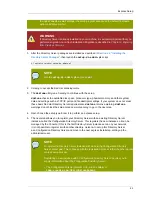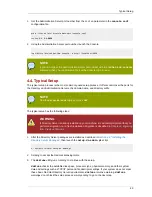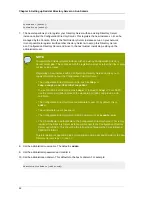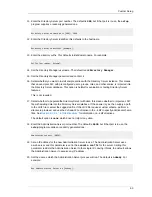
Installing Individual Packages
53
mkdir /tmp/rhds80
cd /tmp/rhds80
2. Download the Directory Server packages from Red Hat Network. This can be done through a web
browser by logging into Red Hat Network and selecting the
Red Hat Directory Server 8.0
channel
or it can be done using a tool such as
curl
or
wget
with information available on the Red Hat
Network channel.
3. Install and update the Solaris packages using
pkgadd
.
for pkg in *.pkg ; do
pkgadd -d $pkg all
done
If another application such as Red Hat Certificate System is already installed on the server,
pkgadd
detects the shared packages. Make sure that the
pkgadd
program replaces any existing
versions with the packages included with Directory Server.
4. When the
pkgadd
program completes, move all
*.pkg
files from the current directory to a backup
directory.
5. Delete the temporary directory.
rm -rf /tmp/rhds80
6. After the Directory Server packages are installed, run the
setup
program to set up and configure
the default Directory Server instance and the Administration Server.
/usr/sbin/setup-ds-admin.pl
7. Accept the initial screens for licensing and
dsktune
output, then select the setup type, and
proceed with configuring the new Directory Server instance.
•
Section 5.3, “Express Setup”
•
Section 5.4, “Typical Setup”
•
Section 5.5, “Custom Setup”
NOTE
Directory Server version 8.0 conforms to the Filesystem Hierarchy Standards. This
means that the directories and files are in different locations than previous versions. For
more information on FHS, see the
http://www.pathname.com/fhs/
homepage. For a table
showing the new file locations, see
Section 7.1, “Directory Server File Locations”
.
Содержание DIRECTORY SERVER 8.0
Страница 32: ...24 ...
Страница 46: ...38 ...
Страница 90: ...82 ...
Страница 98: ...90 ...
Страница 128: ...120 ...






























